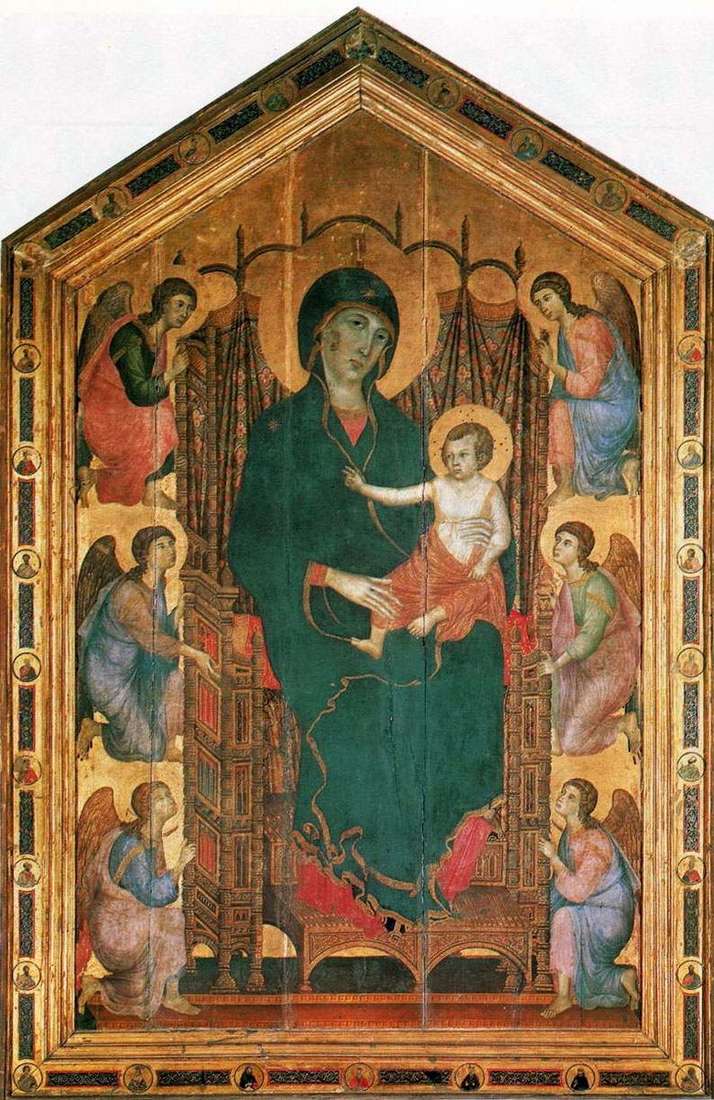
On the front side of the board recorded on two sides, the Madonna is represented in the form of the Queen of Heaven and Queen of Siena. On both sides of it are long solemn ranks of angels and saints. In the foreground are the patron saints of Siena: St. Ansaniy, St. Bishop Savin, martyrs of St. Crescient and St. Victor. Standing on their knees, they ask for protection from the lady of the city. Follow them from left to right: St. Katerina, St. Paul and St. John the Evangelist, and at the very throne on both sides – two angels. On the right, the series closes the St. John the Baptist, St. Peter and St. Agnes.
The second row consists of dignity-filled angels, six on each side. Behind the throne there are also angels, who look with deep respect to the Madonna. The full-face white marble throne with inlaid Kosmateco inlays, like the gates of the temple, embraces from both sides the Madonna, whose figure in a dark blue cloak clearly appears on the background of a silk brocade, embroidered with gold, on the throne. The only decoration of the cloak of the Madonna is a narrow golden rim, whose coils are softer and more natural than Madonna Rucellai. The picturesque reflections of folds are also more believable, they no longer simply adorn, but express forms and movements. The baby, sitting on Madonna’s lap, is also naturally written, his gaze is directed directly at the viewer, but he does not bless, but holds his cloak on his chest.
The inscription of gold on the edge of the pedestal of the throne testifies to the deep artistic self-awareness of Duccio. He asks in her for the Madonna of rest for Siena and for himself, as he so beautifully portrayed her: MATER SCA DEI / SIS CAUSA SENIS REQUII / SIS DUCIO VITA / THE QUIA PINXIT ITA. “
On the back of the board are written scenes of the Passion of Christ. “
Until 1505 the picture of Duccio adorned the main altar of the Siena Cathedral. In 1771, it was dismantled into parts, separating the pictures of the pediments and the limit. The original frame of the picture is lost. The shape of the pediments and the theme of their painting can not be reconstructed accurately today.
 Madonna Rucellai by Duccio di Buoninsegna
Madonna Rucellai by Duccio di Buoninsegna Maesta. The Healing of the Blind by Duccio di Buoninsegna
Maesta. The Healing of the Blind by Duccio di Buoninsegna Maesta. Annunciation by Duccio di Buoninsegna
Maesta. Annunciation by Duccio di Buoninsegna Washing feet by Duccio di Buoninsegna
Washing feet by Duccio di Buoninsegna Madonna and Child with Angels by Tommaso di Giovanni Masaccio
Madonna and Child with Angels by Tommaso di Giovanni Masaccio Madonna Rucellai – Duccio di Buoninsegna
Madonna Rucellai – Duccio di Buoninsegna Lavado de pies – Duccio di Buoninsegna
Lavado de pies – Duccio di Buoninsegna Madonna with Child and Angels (Madonna of Onisanti) by Giotto
Madonna with Child and Angels (Madonna of Onisanti) by Giotto